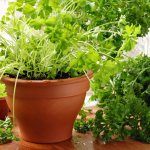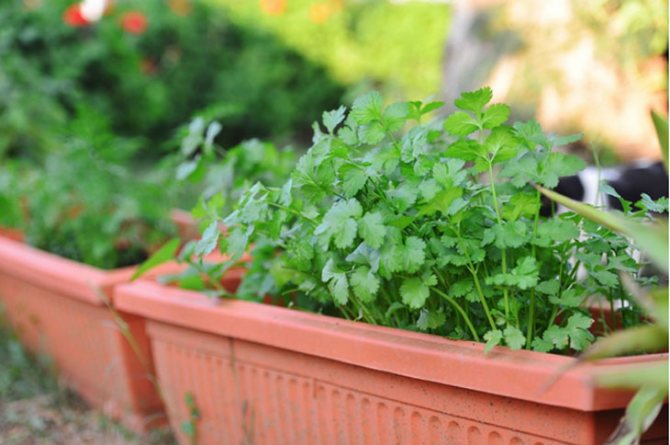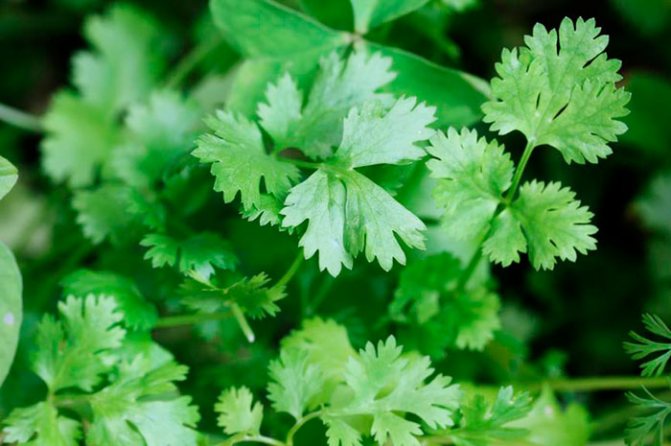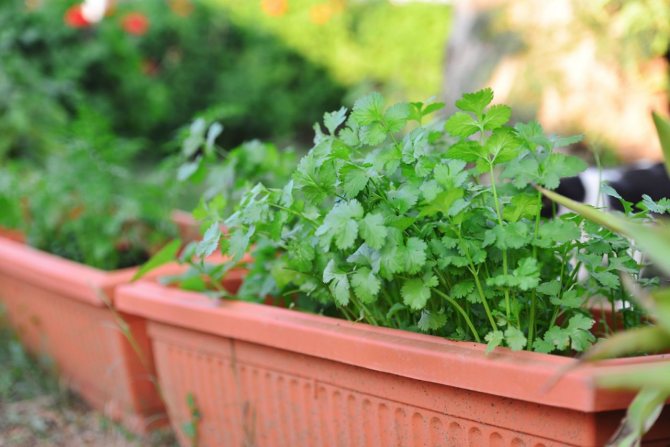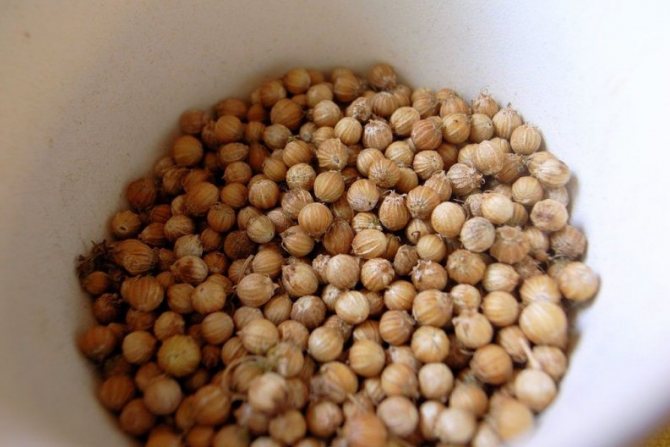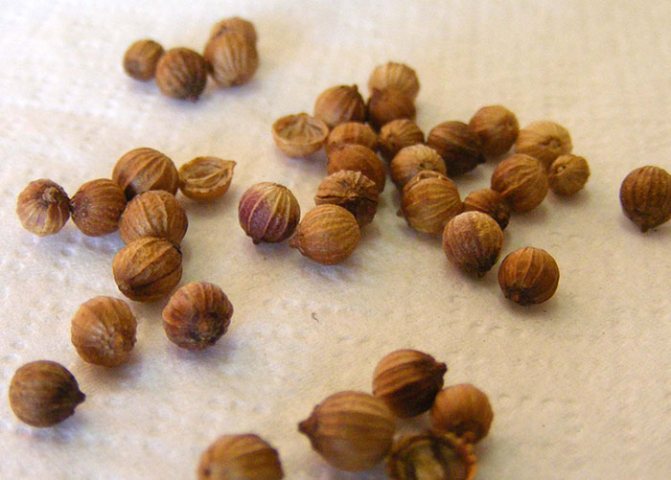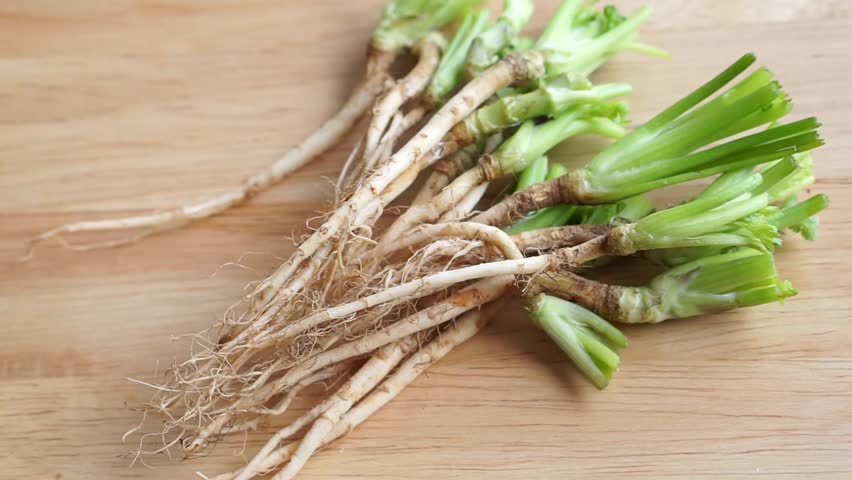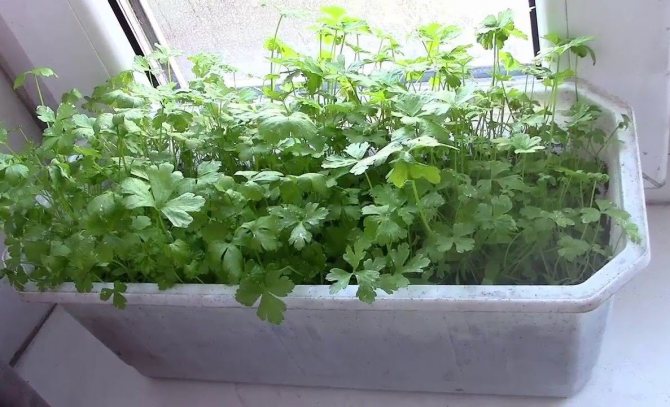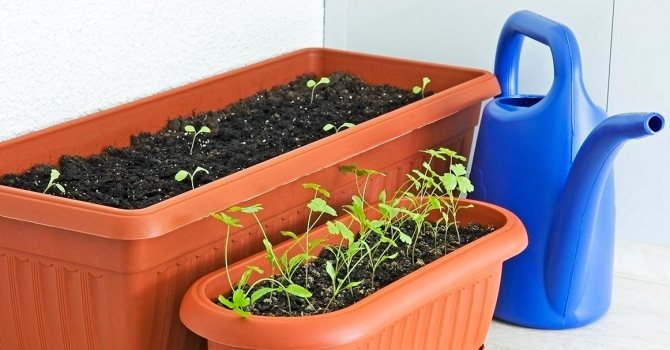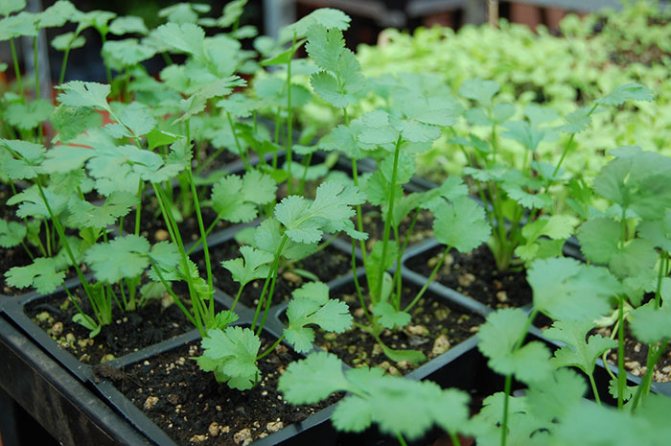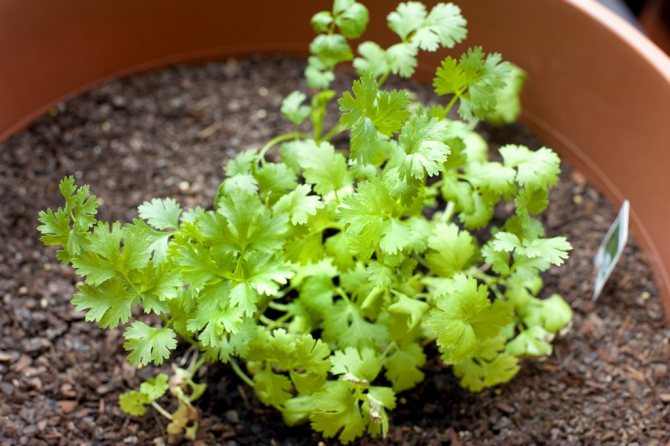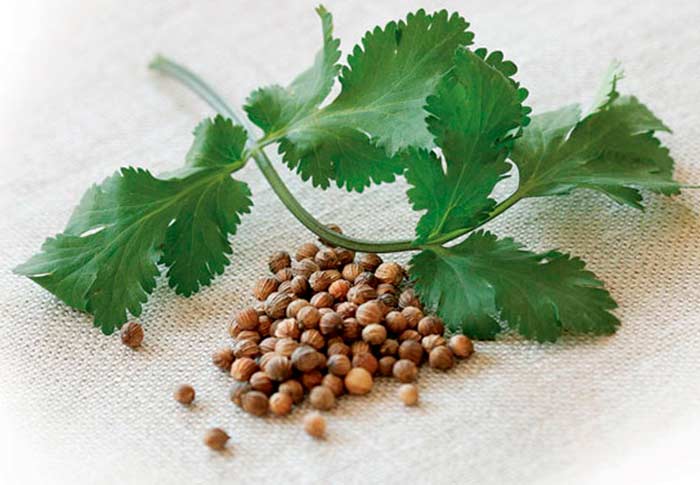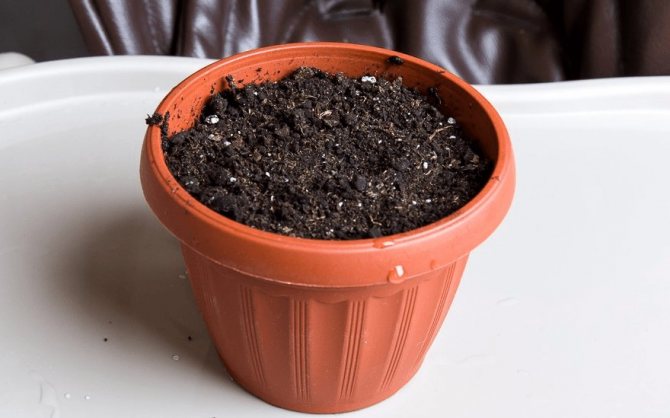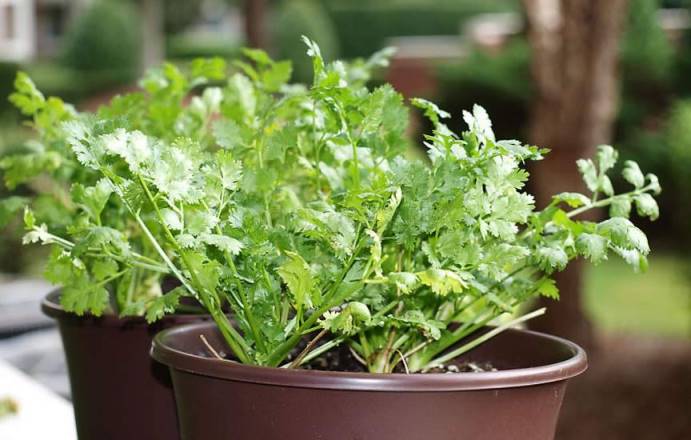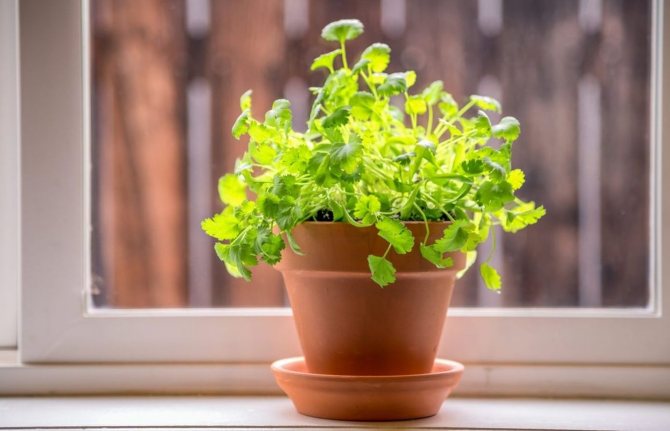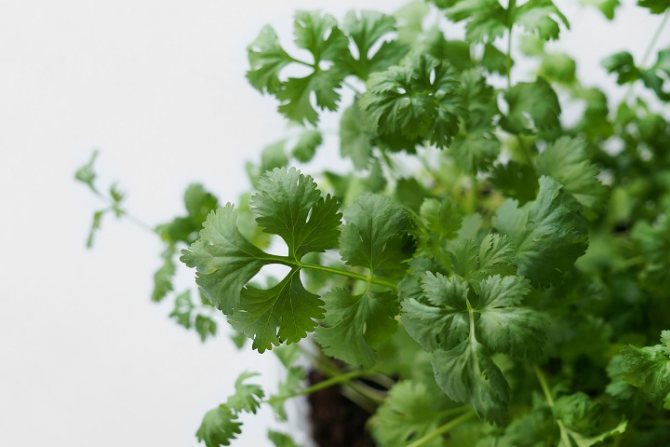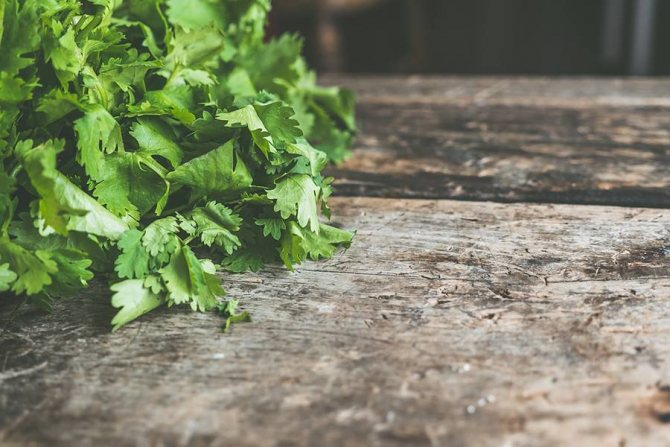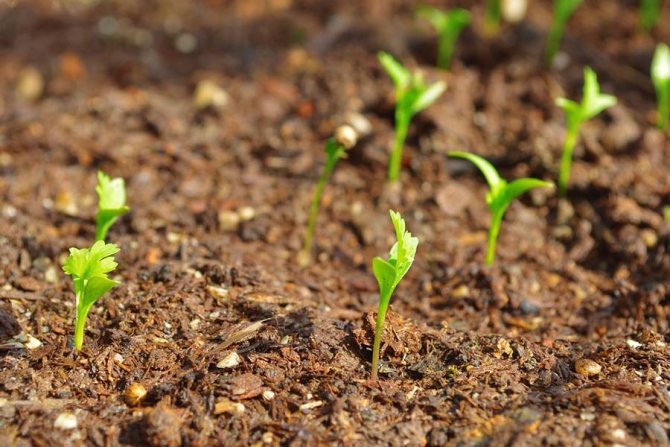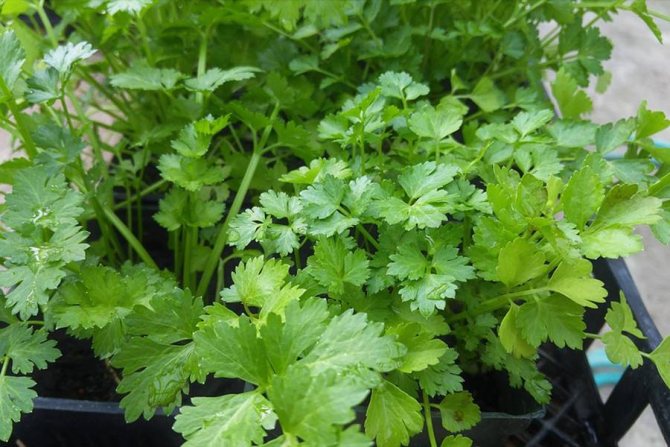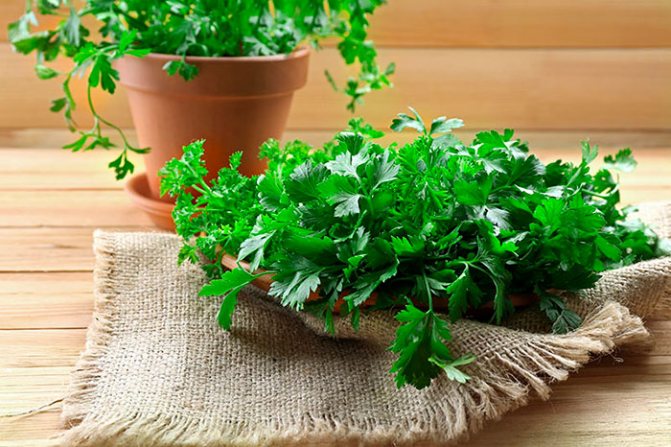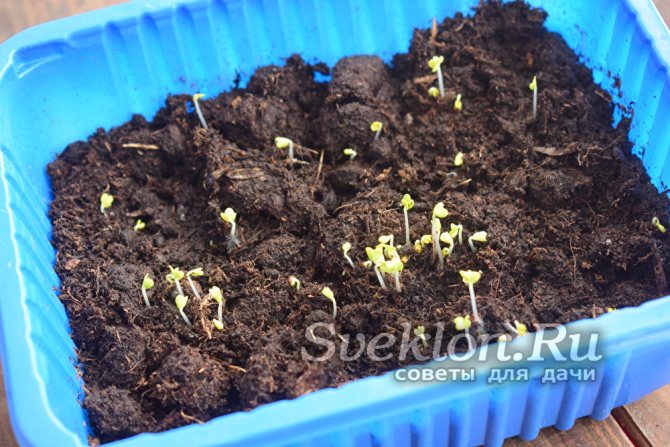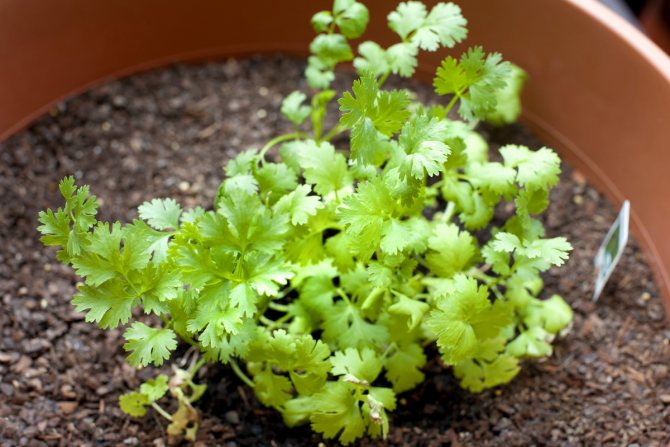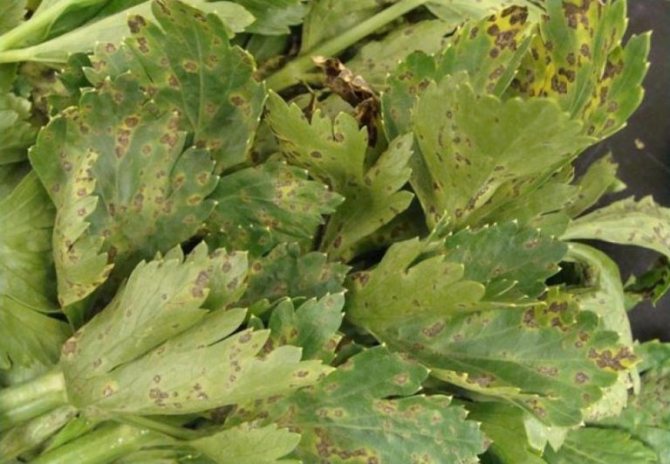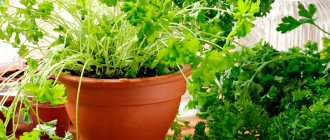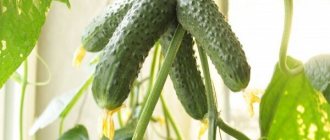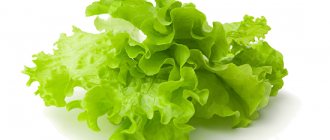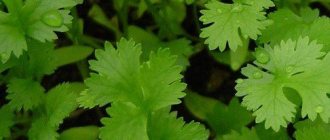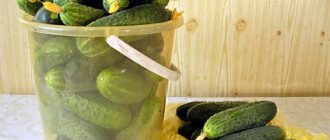Cilantro and coriander are one plant. The first name is taken from the Georgian language, the second is known in Europe. The difference is that the seeds and root are called coriander, and the green leaves are called cilantro. Cilantro on a windowsill in an apartment is an excellent source of nutrients that you can use to replenish your body in winter. It grows well on the window, it is easy to care for it. The plant looks like parsley. Umbellate inflorescences. Flowers are pink or white. The taste and smell of cilantro changes after flowering. Ripe seeds smell strong and have a sweet-spicy taste. They and green leaves are used as a seasoning.
What are the beneficial properties of cilantro
The plant contains a whole arsenal of vitamins:
| Vitamin | number |
| Vitamin K | 310 mcg |
| Vitamin E | 2.5 mg |
| Riboflavin | 0.162 μg |
| Vitamin PP | 1.114 mg |
| Vitamin B6 | 0.149 mg |
| Retinol | 337 mg |
| Thiamine | 0.067 mg |
| Beta Carotene | 3.93 mg |
| Ascorbic acid | 27 mg |
| Vitamin B5 | 0.57 mg |
| Choline | 12.8 mg |
| Folic acid | 62 mcg |
There are also micro and macro elements:
| Trace elements | Macronutrients |
| Selenium - 0.9 mcg | Phosphorus - 48 mg |
| Iron - 1.77 mg | Sodium - 46 mg |
| Copper - 225 mg | Calcium - 67 mg |
| Zinc - 0.5 mg | Potassium - 521 mg |
| Manganese - 0.426 mg | Magnesium - 26 mg |
Energy ratio (proteins / carbohydrates / fats) - 37% / 15% / 20%.
Cilantro has a bactericidal, analgesic, soothing, strengthening, wound healing, hemostatic, laxative and choleretic effect.
If you eat cilantro for food, then the blood sugar level will normalize, the pressure will decrease, the blood vessels will strengthen, and toxins will be eliminated.
If you plant cilantro at home, it will still purify the air in the room.
I brew the foliage like tea. This drink is an excellent expectorant for diseases of the upper respiratory tract.
If you are a tea drinker, check out how to grow ginger at home. It is an excellent remedy for colds.
For people with skin problems, I recommend washing with a decoction of coriander. I do these procedures regularly and the condition of my skin has improved markedly.
Author's note
Natalia Papanova
Blog author
People in ancient times believed that if you use coriander seeds, you can gain immortality.
You can also learn about the benefits of greens from the program “Living Healthy”.
Coriander harm
Almost everyone can eat this spicy herb, there are no contraindications. It can only be harmed with unlimited use. Due to excessive use, the surface of the skin may turn red, sometimes rashes and swelling appear on it. In some cases, the person will feel sick. All these signs indicate the occurrence of an allergic reaction to the product used.
In addition to manifestations of an allergic nature, abuse leads to the fact that:
- insomnia appears;
- memory deteriorates;
- menstruation is disturbed;
- bleeding increases;
- the blood becomes thicker;
- blood clots are formed.
Cilantro varieties for growing at home
If you want to grow cilantro in an apartment all year round, then initially select the appropriate variety. For growing at home, I think the most suitable are leafy ones.
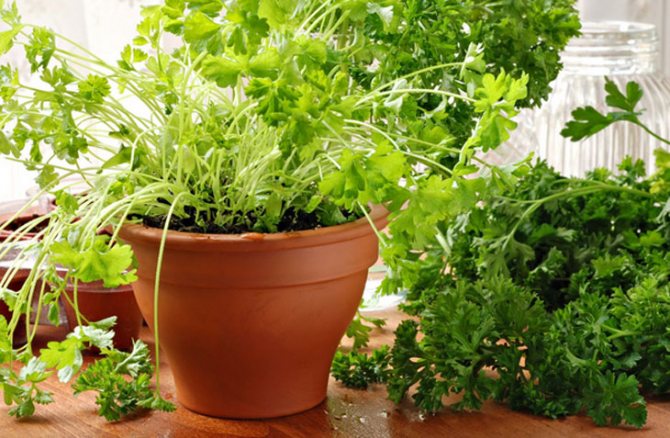
Undersized and early maturing varieties are ideal for growing on a windowsill.
| Name | Ripening terms | Are they difficult to care for | External description | Features of the variety |
| King of the market | 30-35 days | Unpretentious, loves good watering. | The bush is compact - up to 50 cm high. The foliage is fragrant, juicy, green. | Not picky about temperature conditions. Disease resistant. |
| Beam | 29-35 days | Loves moisture, not picky about heat. | Compact and semi-upright. The leaves have a strong spicy aroma, juicy and tender. | High-yielding and good honey plant. |
| Early | 30-45 days | Unpretentious care. | Strongly branched, up to 50 cm high. The foliage is large and strong, with a pleasant aroma. | Resistant to shooting, shedding, drought. |
| Vanguard | 40-80 days | A variety that is undemanding to moisture. Sun-loving, but grows in partial shade. | Height - 25-30 cm. The foliage is glossy, dark green. | Fragrant and fruitful. |
| Alekseevsky 413 | 50-90 days | Needs regular watering and warmth. | The bush is erect, highly branched, capable of reaching 60 cm in height. The foliage is smooth, light green. | There is resistance to drought, shedding, lodging. |
What you need to grow cilantro in a seed pot on a windowsill
Now I'll tell you what you need to successfully grow cilantro in your apartment.
Choosing the best place in the house
Initially, I determine where the cilantro will grow. She likes warm and sunny places. The most suitable place is a windowsill on the south side.
Author's note
Natalia Papanova
Blog author
This spice came to us from the warm Mediterranean coast.
Selection and preparation of containers
I select the landing container the one in which the cilantro will "breathe". It can be an earthenware pot without enamel or a plastic pot. Another suitable option is a wooden box.
Since the roots of cilantro are spreading and powerful, the size of the flowerpot should be impressive: 40-45 cm deep, 30-35 cm wide.
Soil selection
Cilantro cannot be called whimsical to the soil composition, but it is better if the soil mixture is breathable. The harvest will please if you plant cilantro in fertile, loose and sandy loam soil. I take universal slightly alkaline (pH 7-8) or neutral soils (pH 6.5-7), which are sold in special stores (for example, universal soil "Exo", "Ogorodnik", "Terra Vita", etc.). They contain all the necessary elements (phosphorus, potassium, mineral nitrogen).
Author's note
Natalia Papanova
Blog author
Sour soils are not suitable for cilantro.
Sometimes I take land from the garden, but I definitely disinfect this one. I do this using a hot solution of potassium permanganate (I dilute 2-5 g of potassium permanganate in 10 liters of hot water) or I steam the earth in the oven for half an hour.
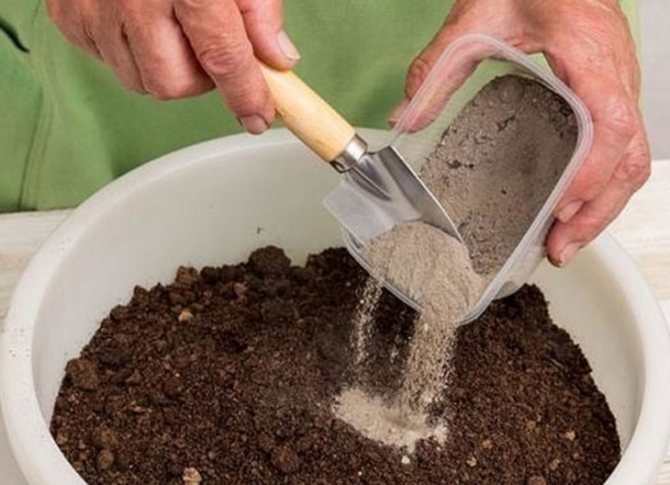

It's easy to prepare the soil mixture with your own hands
I make the nutrient soil myself, from the following components:
- humus - 1 part;
- sand - ½ part;
- turf land 1 part.
Drainage is important, because it maintains the required level of moisture, prevents water stagnation and root decay. Initially, I make drainage holes at the bottom of the pot. The larger the container, the more holes there are. Their diameter should not exceed 0.5 cm. Then I pour out pebbles, expanded clay or other material (3-5 cm). And only after that I have the soil mixture.
Do you want to have other greens at home? Then see how to grow lettuce on the windowsill.
Necessary conditions: lighting, air humidity, temperature
For cilantro to be comfortable, you need to worry about the climatic conditions in the room.
Cilantro is light-requiring, so I place the pot in a well-lit area. If the days are short, I turn on the lighting devices (incandescent, fluorescent, mercury) for 8-12 hours. With a lack of light, the plant does not produce lush greenery.
Cilantro temperature drops are not terrible, it does not die at -10 ° С and + 30 ° С.But, if the room is too cold or hot, the plant will be lifeless, weak and will slow down its growth. Therefore, I follow the temperature regime.
It is also equally important to maintain the right humidity in the house. Here humidifiers or placing containers with water around the room help me. Excessive dryness should not be allowed or vice versa.
Do you like spices? Then read up on how to grow rosemary at home! It is completely unpretentious in care, and the aroma is simply amazing!
Growing cilantro at home?
Well no
Seed preparation
For better seed germination, I prepare them too. I buy fresh planting material, which is no more than 2 years old.
Before planting, I keep the seeds in warm water for 2-3 hours. This procedure promotes the swelling of the shell and stimulates germination.
Author's note
Natalia Papanova
Blog author
Purchase seeds from specialized stores. This will minimize the purchase of contaminated or old seed.
Sowing rules
Seeds, soil and container are ready, now I'm starting to sow. I do everything in stages:
- I make recesses in the ground - 1.5-2 cm.Maintaining the interval between them is 4-5 cm.
- I put seeds in the soil.
- Sprinkle with a loose layer of earth.
- I water from a syringe or spray bottle.
- I cover the container with foil until the first shoots appear, for a greenhouse effect. After the sprouts appear, I remove the polyethylene.
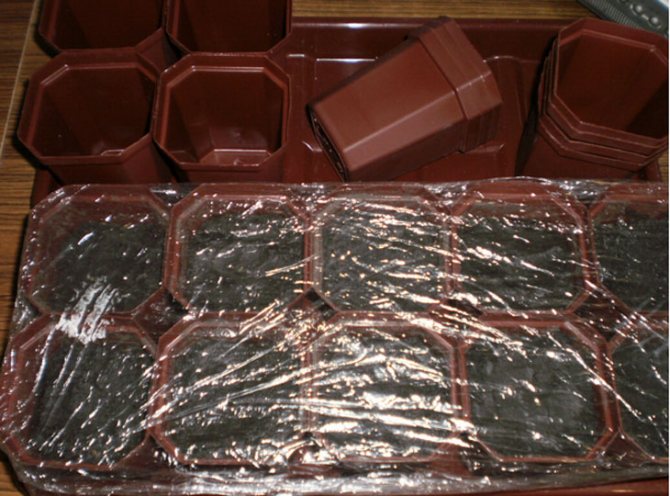

Keep containers in a warm and bright place
How to grow coriander in twists of earth, see the video.
Seedling care
Shoots appear after 10-14 days. After, I transfer the pot to the windowsill. You can go to any other bright place. Polyethylene, as mentioned above, I remove. I periodically spray cilantro from a spray bottle and make sure that the soil does not dry out.
When to plant seedlings
I do not recommend seating cilantro at all. The seedlings may not adapt again. If absolutely necessary, this should be done when there are 2-3 leaves on the plant. Beforehand, I always moisturize the soil well and remove the plants so that the roots are not damaged in any way.
Don't want to stop there? Recently I told you how to grow basil at home, be sure to look!)
Sowing
To grow cilantro on a windowsill, you need to plant the seeds correctly. For this, a number of requirements must be met.
How to plant cilantro in a pot:
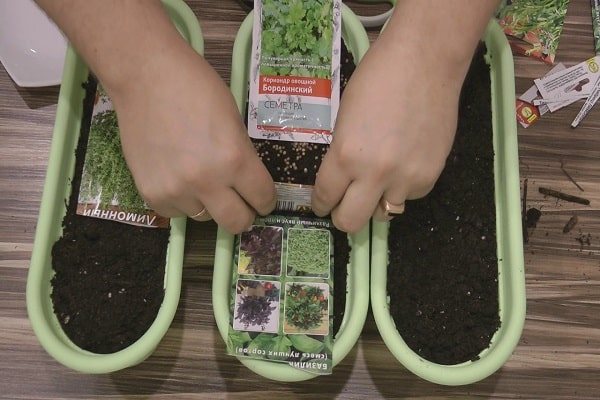

- The bottom of the container must be filled with drainage.
- Then they are filled with nutritious soil, leaving 3 cm from the top.
- Lay out 10 whole cilantro seeds or 20 separate ones (depending on the width and length of the container, the number of coriander seeds varies). One round seed yields 2 plants.
- Cover with earth, layer thickness 1-1.5 cm.
- Moisten the ground, it is recommended to use a spray bottle.
- The pots are placed in a warm, dark place, covered with plastic or glass.
- Until the cilantro sprouts, the soil is kept moist.
- Coriander seeds need 7-10 days to germinate.
If cilantro seeds are soaked for 1 to 2 hours before planting, they will sprout faster. As soon as shoots appear, the pot is placed on a lighted windowsill, the polyethylene is removed.
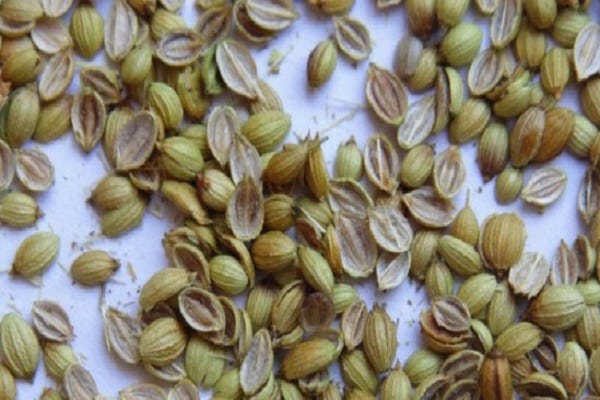

Home care for cilantro
Despite the unpretentiousness of the plant, I always follow the temperature and humidity of the air, lighting. I water and feed on time.
Illumination
Good lighting is the key to a successful harvest. Daylight hours for cilantro should be at least 12 hours. If the day is short in winter, be sure to include additional lamps.
Author's note
Natalia Papanova
Blog author
For uniform growth and fluffiness, I advise you to periodically turn the container from different sides to the light.
Temperature regime
The optimal temperature regime for cilantro is not less than +15 and not more than + 24 ° С. Sudden temperature changes are undesirable.
Air humidity
The normal humidity level is 40-60%. To maintain balance, I often ventilate the room. In the autumn-winter period, I put containers with water in the room or turn on a humidifier.
How often to water
Cilantro is a lover of abundant watering, but I also do not allow stagnant water in containers. In very moist soil, roots rot and pathogens quickly start. All this will lead to the death of the plant.
Watering rules
- Water the cilantro 2-4 times a week. Reduce the amount of watering in winter, increase in summer. Do this more often during active growth.
- Use plenty of water. Always discard any leftovers from the pallet.
- Spray the leaves with a spray bottle.
- Water only with settled water at room temperature.
A few minutes after watering, I recommend loosening the soil. This procedure will provide oxygen to the root system.
Top dressing
I do not neglect feeding and I do not advise you. I spend them 2-4 times a month. I start fertilizing the cilantro after the first rosettes appear and the sprouts get stronger.
I use liquid mineral complex fertilizers ("Rainbow" or "Ideal"). I dilute with water in a ratio of 10 ml per 1 liter. I water at the root, 3-4 hours after watering with water.
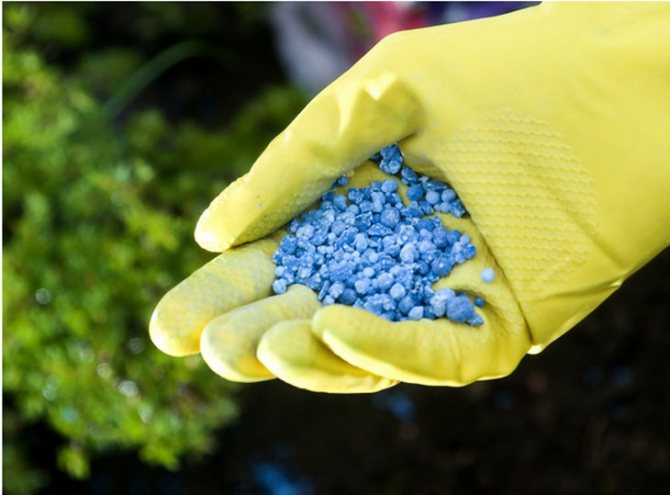

The plant loves mineral fertilizing
Do I need a transplant
Cilantro transplant is difficult. It is better to refrain from it. I sow seeds directly into large containers and just thin out the seedlings.
Features of the pick
Avoid thickening of the landings. I thin out the beds when 1-2 leaves appear on the seedlings. I remove thin and weak shoots.
Author's note
Natalia Papanova
Blog author
The distance between seedlings should be 8-10 cm.
Things to take care of before boarding
Given the fact that coriander does not tolerate transplants very well, and its root system is of a decent size, the seeds should be sown immediately in a pot that is suitable for the size. A rectangular clay container with a depth of at least 30 cm is perfect for this. Moreover, it should be without enamel. This will allow air to flow through the porous walls to the roots.
Attention! A container designed for planting cilantro must necessarily have holes on the bottom for excess water to drain. Coriander does not tolerate its stagnation.
For planting in a pot, a ready-made substrate from a store is suitable. If it is not possible to purchase it, you can make a soil for cilantro yourself. Includes:
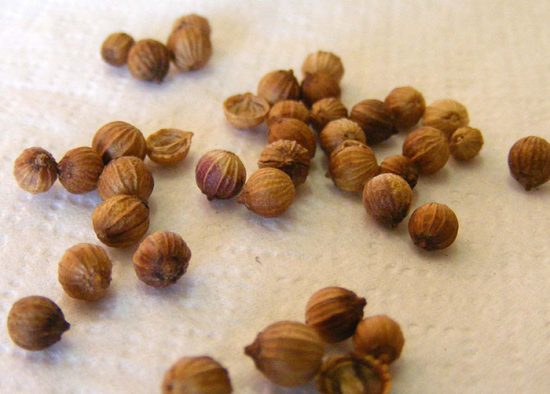

The first components are mixed in a 2: 1 ratio, after which 2-3 tbsp is added. ash per 1 kg of substrate.
It is worth taking care of the further location of the pot, because cilantro is very fond of light. In shading, its stems are strongly elongated, fewer leaves grow on them. Therefore, for a short day, the plant needs additional lighting. The lack of light is compensated by using fluorescent or special phyto lamps.
Flower bed design. TOP 10 simple and effective techniques
The air temperature in the room where the coriander is grown should not fall below + 15 ° C, because the plant comes from warm regions and stops growing and developing in cooler air.
Features of growing cilantro on the balcony
Cilantro on a closed balcony can grow all year round. Listen to the recommendations of experienced gardeners. They will help you get a good harvest:
- You cannot plant other crops with cilantro, especially parsley or dill - it does not tolerate any neighborhood.
- Planting containers should be selected from natural materials (wood, clay).
- It is not advisable to expose cilantro pots in a draft.
- It is important to constantly cut the stalks. If this is not done, then all the forces will go to the formation of seeds, and not to the green mass.
- No need to transplant cilantro. Sit her down at once in a permanent place.
Also, do not forget to sow cilantro in stages so that fresh herbs will delight you all year round.
Ground requirements
Growing cilantro from seeds will not give a good result when sown in poor soil. For planting, you can take different soil, the main thing is that it is loose and fertile. This could be:
- nutritious garden soil;
- purchased universal primer;
- a mixture of equal parts of turf and humus with the addition of 0.5 part of sand.
The soil must be disinfected by steaming in the oven for 20-30 minutes. This procedure can be replaced by spilling with a hot solution of potassium permanganate. Purchased soil does not need to be processed, it goes through all the necessary procedures in production.
Land preparation should be done 5-7 days before the expected sowing date. By the time of planting, excess moisture should evaporate from the soil, and it will take time to restore the soil microflora.
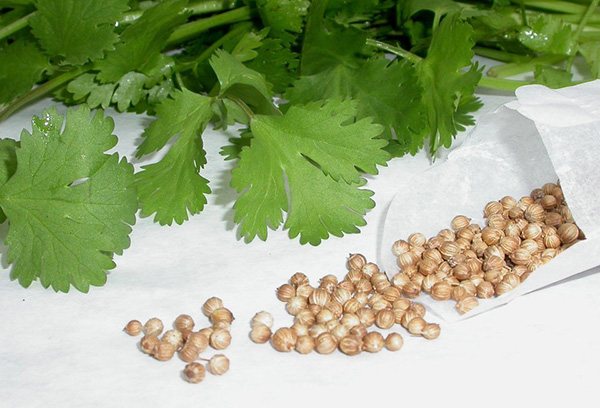

How to care for cilantro in winter
In winter, the days get shorter and colder comes, and this affects the growth of crops. To make cilantro produce lush greens and grow actively, I:
- put additional lighting;
- I maintain the desired temperature regime;
- I provide optimal humidity in the room;
- watering cilantro 2-3 times a week;
- I do not allow drafts.
Compliance with all points increases productivity.
In addition to cilantro, I also grow other greens. To expand your horizons, I recommend reading how to store onions at home all winter. Observing all the conditions, the onion will remain until spring and will not germinate.
Harvesting
Unlike collecting cilantro greens in the beds, plants from the windowsill are never cut to the root. Leave 1 cm of the length of the stems. Then the cilantro leaves will start growing again.
Cut coriander leaves, the length of which is not less than 15-20 cm. To continue the growth of greenery, small central leaves are left.
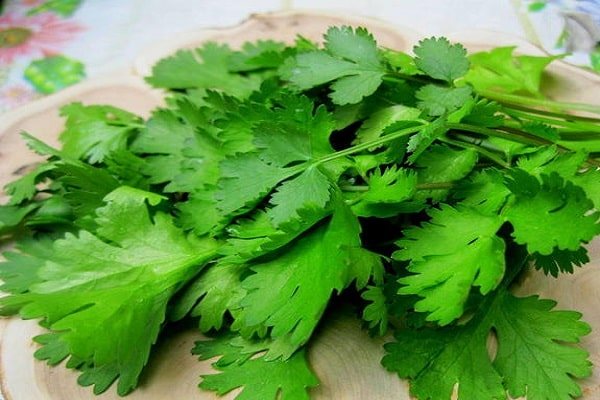

The peculiarity of cilantro is that it dies off very quickly. In order not to be left without coriander, you should plant new seeds every 2-3 weeks. Then you will provide yourself with cilantro greens for a long time.
Coriander seeds are harvested when they are easily removed by hand. Most often, their color changes to light brown. The cilantro is thoroughly dried.
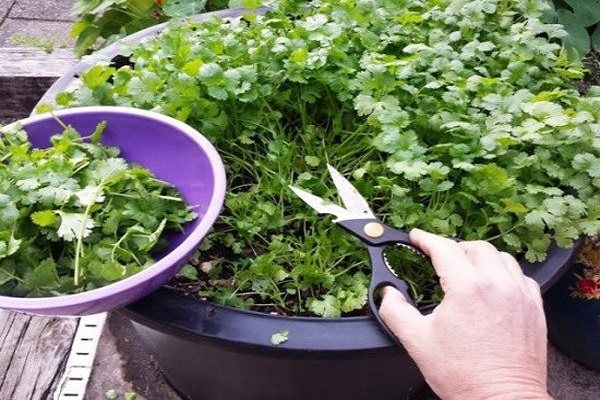

Diseases and pests
If cilantro grows in a room, the chances of contracting diseases or pest infestations are minimal. But even on the windowsill, she will suffer if you do not follow the rules of care.
Possible diseases:
| Name | Causes of occurrence | Manifestations | Control methods |
| Powdery mildew | High room temperatures, dry air. There is a lot of nitrogen in the soil. | Stems and leaves are covered with white bloom. | The affected plant parts are removed. After that, fungicides (Skor, Fundazol), biofungicides (Planriz, Fitosporin-M, Gamair) are used. folk remedies also help - a solution of soda, ash, yogurt. |
| Ramulariasis | Excessive humidity. | The foliage is dotted with brown spots. | Fitosporin, Alirin-B or garlic infusion will help to eliminate. |
| Rust | Abundant watering, an excess of nitrogen-containing fertilizers, thickened plantings. | Orange or brown spores appear on the inside of the leaves, yellow spots appear on top. Over time, the foliage turns yellow, blackens and dries up. | Use fungicides (Azofos, Vectra, Topaz, Skor) or folk remedies (infusion on weeds or a composition of soda, soap, aspirin). |
There are also pests that attack cilantro:
| Insect name | Appearance | Danger to the plant | Ways to fight |
| Seed eater | Wasp-like insect, no more than 2.5 mm long. The body is black, shiny, the legs are brown. | It gnaws the entire insides of the seeds and they lose their germination. | Disinfection of seeds with Naphthalene, Dichloroethane. |
| Umbrella moth caterpillar | Brown with a reddish tinge, up to 1.3 cm. Body with bristles and hairs. | It eats inflorescences, pedicels, flowers, leaves and set fruits. Also braids them with cobwebs. | Treatment with insecticide preparations such as Aktara, Iskra, Mospilan will help. |
| Striped bug or line bugs | Dyed red, with black stripes, about 1 cm long. | It pierces the shell of immature seeds, sucks out the contents, after which they die off. | Chemical control methods are not appropriate. It is necessary to manually collect the bugs, and cover the unripe seeds with gauze and tie them, after which the shield bugs will not get to them. |
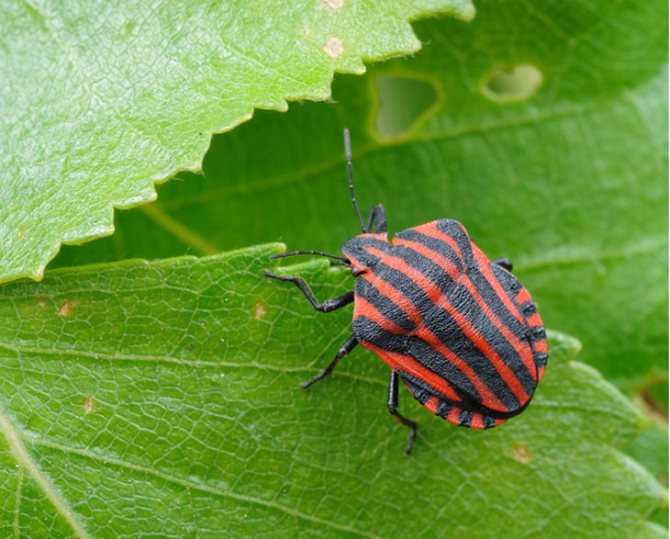

Usually insects wield in the open field.
Author's note
Natalia Papanova
Blog author
You can infect cilantro at home only through untreated soil.
Frequently asked Questions
Below I have collected the most frequent questions that they write to me. I answer them in order).
Sowed cilantro in unsuitable containers. When can you transplant?
Cilantro does not tolerate transplants very well, but you can try. Before doing this, I moisten the soil well. I take out the seedlings so that the roots are not damaged. The best time for the procedure is when 2 leaves appear.
How do you know when it's time to cut your greens?
Harvest when the rosette has formed. The first foliage is needed for cilantro for photosynthesis.
What's the best thing to take for drainage?
Various materials are suitable - pebbles, expanded clay, gravel. I think the best option is a synthetic winterizer.
Why remove cilantro stalks?
It is necessary to remove peduncles so that the cilantro is fluffy, spreading, aging more slowly.
Can other plants be planted nearby?
Not. Cilantro does not tolerate any neighborhood.
How much cilantro grows at home?
In apartment conditions, cilantro can grow constantly. For this, I periodically sow.
Where is cilantro used?
Cilantro or coriander is used in cooking, medicine, cosmetology and perfumery.
Due to its medicinal properties, cilantro is indispensable for the treatment of various diseases (anemia, rheumatism, arthritis). It helps me to normalize blood pressure, lowers blood sugar, calms the nervous system.
In cooking, I use fresh and dried cilantro (herbs and seeds). The plant gives my dishes a specific taste and aroma.
Description of the plant
In appearance, the plant resembles a parsley bush. A characteristic feature of cilantro is that its aroma and taste change after flowering, and not only green leaves, but also seeds can be used for food.
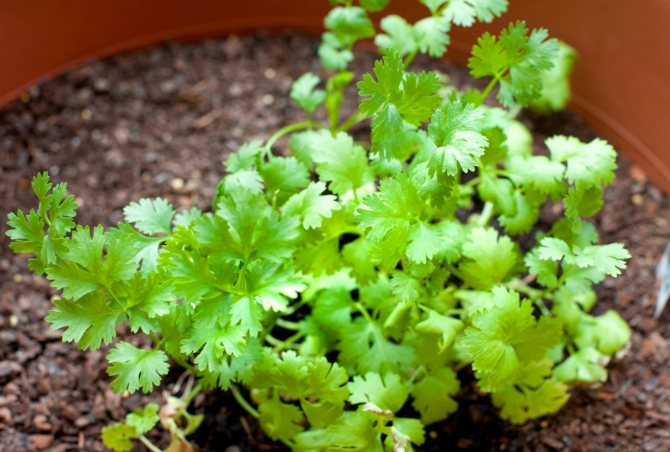

A brief botanical characteristic of coriander is presented below:
- This annual plant belongs to the Umbrella family. It has a straight stem, the height of which is 40–80 cm.
- The root system of the plant consists of a straight taproot and small adventitious roots. With any damage to the main root, cilantro can die, therefore, it is not recommended to transplant it.
- The leaves are arranged on long stalks and are dark green in color. They are dissected and consist of several wide lobules.
- Green leaves have a pleasant citrus flavor and rich aroma, and also contain many vitamins.
- The flowering period begins approximately 2 months after planting. The inflorescences are in the shape of an umbrella, which consists of small white or pink flowers.
- The fruit of the plant is spherical and contains 2 ovoid seeds. It ripens 1.5 months after the start of flowering.
- Ripe seeds of the plant have a strong aroma and sweetish pungent taste, therefore they are used in cooking as a seasoning.
You will be interested to know how to tell the difference between parsley and cilantro.

